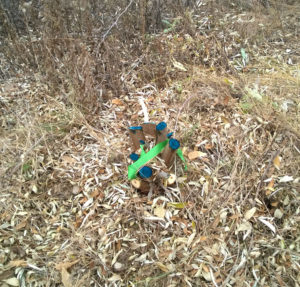By Conner Jackson
A walk through the city of Boise’s Hyatt Hidden Lakes Reserve in the middle of the winter is a great time to see plants in their dormant phase. Especially easy to pick out in the winter at Hyatt is the Russian olive– a non-native small tree or shrub that grows in abundance on the shores of each of the lakes. If you’re a frequent visitor to the reserve, you’ll easily note the spread of Russian olives over the past decade.The City’s embarking on an ambitious plan to reduce the Russian olive population at the reserve, a plan that will improve bird habitat at the reserve.

Russian olive, Elaeagnus angustifolia., is a deciduous shrub or small tree native to southern Europe and Asia. It has thin, silvery-gray leaves and reddish bark that is commonly covered in sharp thorns. They can grow up to 45 feet tall.

Right now, the leaves of Russian olives have fallen, but in the springtime, the trees will leaf out and produce yellow flowers and small, oval shaped fruits. Those fruits will likely be eaten birds and other animals in the reserve when they are fully ripened in the fall.
Russian olive trees are very capable plants that have spread widely since their introduction. They can tolerate infrequent fire, browsing, temporary flooding, and mechanical cutting. Russian olive can grow from seeds dispersed by wildlife, stump sprouts, stem cuttings, and root pieces. They were planted across North America since the early 1900s for windbreaks, erosion control, and to provide food and cover for wildlife. Russian olive trees are found extensively in wet-saline and riparian environments, including Hyatt Hidden Lakes Reserve.
The problem is the Russian olive is too capable. The trees are quick to displace native species such as willows and cottonwoods by outcompeting them for resources, including access to sunlight and water. The Russian olive is a poor replacement for the native plants. Aside from their fruit Russian olive trees are not edible by birds and wildlife found in in the Boise River watershed. They can crowd out other plant species that provide great habitat for wildlife.


The City of Boise, as part of a reserve habitat improvement project, is removing Russian olive trees. Both City Forestry crews and volunteers, including BREN members, are involved. The goal is to prevent Russian olive trees from completely crowding out desired native species. Trees of all sizes are being removed and stumps are being treated with herbicide so they don’t re-sprout. Vegetation is so dense around the lakes, that open spaces created by Russian olive removal are expected to be quickly filled by native plants. Not every Russian olive tree will be removed to preserve aesthetics and the buffer between Maple Grove Rd. and the reserve.
Learn more about BREN’s cooperative Hyatt Hidden Lakes Reserve Habitat Enhancement Project. Join BREN, the Land Trust of the Treasure Valley and City of Boise for a Hyatt Reserve Open House where you’ll hear from Conner and others.